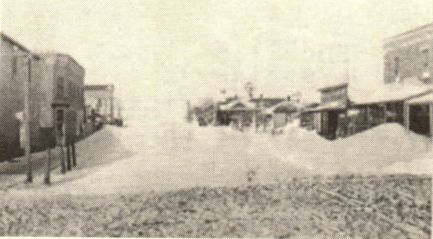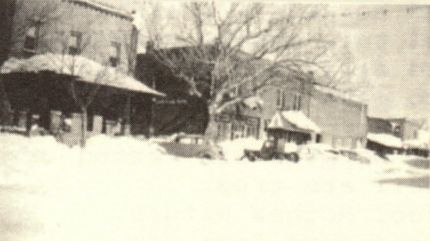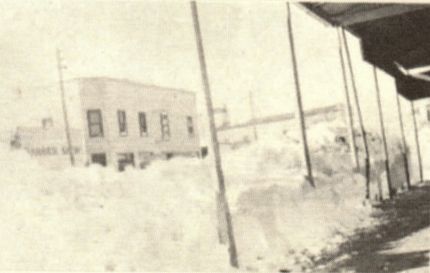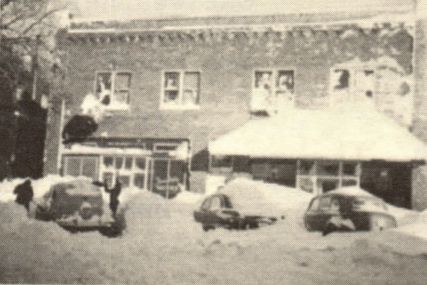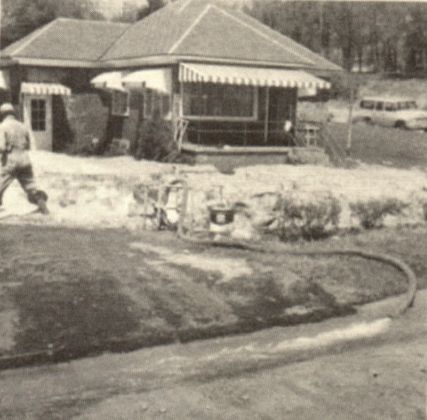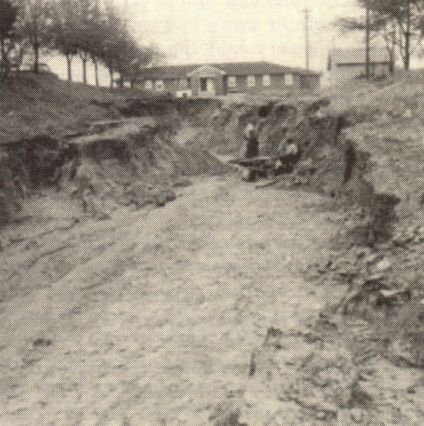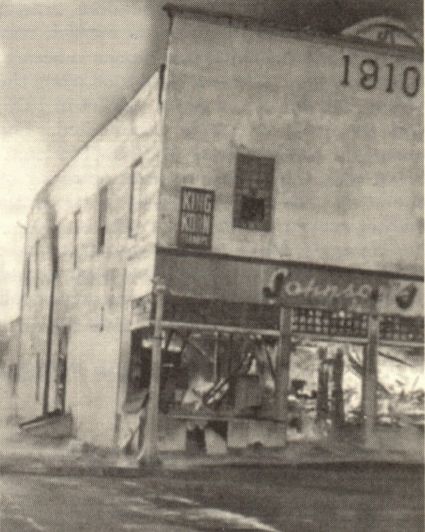Of the natural disasters that struck fear to
the hearts of the area residents, and espe-
cially the early pioneers, the worst was
probably the prairie fires. A single bolt of
lightning in the tall, tinder dry grass; or a
carelessly dumped pan of hot stove ashes; or
a cigarette butt could be whipped into a
raging inferno in short order by the wind. The
railroad was also responsible for many fires
by throwing hot clinkers or cinders into the
dry grass along the tracks. With no means of
communication between settlers, the first call
for help would be the smell of smoke or the
sighting of a plume of smoke on the horizon,
and often by the time a force could be
gathered to fight the fire, it would be raging
out of control. Leaving the women and
children to guard the homestead, the men
would drop whatever they were doing and,
gathering shovels, wet gunny sacks, plows
and a water jug, would go toward the smoke,
sometimes driving many miles before reach-
ing the actual blaze. In the early days the
abundance of tall grass and few barriers, the
fires could burn unchecked for many miles.
One of the worst fires recorded, started in the
northwest corner of the sandhills and burned
over 175 miles into Custer County in the fall
of 1892.
In November 1894 the Virginia settlement
north of Mullen was swept by a fire that
claimed the life of Elisha LeLaCheur and his
brother-in-law John Bliss. Son John LeLa-
Cheur was saved by being dragged to safety
by a team of frightened horses.
In 1905 a Kinkaider by the name of Hicks
lived in the valley north of Dry Valley. He
carelessly dumped hot ashes on the ground
and started a fire that jumped the Middle
Loup river and burned far into Thomas
County.
The Hooker County Tribune dated Octo-
ber 14, 1921 tells of a west bound Burlington
freight train starting a fire two miles east of
Hecla that spread over a big strip of the
country to the southeast. A heavy wind was
blowing from the northwest and the headfire
was carried at a rapid pace for more than nine
miles before it could be stopped.
On March 6, 1972 a fire believed caused by
a cigarette butt or a match thrown from a
passing vehicle set a blaze along the east side
of Highway 97 two miles south of Mullen.
This fire, fanned by a stiff west wind, burned
to the west edge of the Nebraska National
Forest near Halsey, and blackened a strip of
land 32 miles long and from 5 to 12 miles
wide. No human lives were lost, but many
cattle perished or had to be destroyed, and
buildings, shelter belts and winter feed went
up in smoke. Coming at the beginning of
calving season made this fire especially costly
for the ranches in its wake.
The Mullen Cooperative Oil Company fire,
which occurred in May 1956, is covered in this
book in the story `Fire Destroys Co-op.'
Fire starting near the basement furnace
destroyed two businesses in the Johnson
building on Friday morning, November 30,
1974. These businesses were Macke's Grocery
and Lee's Meat Market. Fire was first noticed
when smoke filled the two-story building and
by the time persons in the building got
outside, the front of the store blew out. Fire
departments from Thedford and Hyannis
aided the Mullen department in fighting the
blaze. Neither Ed Macke or Lee Isom, owners
of the businesses, were able to save anything,
including business records, checks, cash or
personal items. Customer-owned meat and
other frozen items in the lockers apparently
were not damaged although some packages
were smoked. The bulding was constructed
in 1910 by the late J.L. Roseberry and had
been used as a grocery store most of the years
of its existence. For a while the upper story
was used as a dance hall and theater, and at
the time of the fire was stocked with clothing
and dry goods. The building was owned by
Mrs. Pearl Johnson, and was completely
destroyed. Johnson Feed Store was in the
process of completing an office on the west
side of the building, and it too was heavily
damaged by the fire.
Lightning is believed to have struck the
electrical wires at the rear of the Mullen
Motor building sometime during the night of
April 21,1978. The wooden rafters in the
building were ignited and when the blaze was
discovered about 1:00 A.M. the fire had too
much of a start to be extinguished. The
interior of the building was completely gutted
and all machinery and shop tools were
destroyed. Also lost were two customer-own-
ed pickups. The outer walls, which were built
from tiles from the dismantled Antioch
Potash Works, remained standing, and Mr.
Almond Elliott rebuilt and reopened his
business.
Following a hot, humid day in the late
spring or summer, area residents watch with
apprehension the towering thunderheads
that build in the western sky. Although
tornadoes are not as common as in the
eastern part of the state, they do occur. The
October 5, 1923 edition of the Hooker County
Tribune tells of a tornado that struck the
James Murray home northeast of Mullen.
The house `was torn to kindling wood and the
occupants carried some seventy-five yards
into the field. It is thought the husband and
father was killed instantly as his body was
badly mangled and skull fractured. Mrs.
Murray suffered severe bruises about the
body but death had not claimed her when
found by Lester Parsons and another neigh-
bor at 6:45 the following morning. The
children had been carried by the storm to
within a short distance from the spot where
their mother . . . (lay). Mrs. Murray died
from her injuries but the two sons survived.
This tornado cut a narrow swath about three
miles long.
Another tornado, described in the Hooker
County Tribune of May 2, 1940, occurred
southwest of Mullen. The storm totally
destroyed the buildings at the D.A. Haney
ranch while the family was away. Mr. and
Mrs. Art Haney and their three children and
a hired man were passing the D.A. Haney
place at the time of the tornado, and barely
escaped injury by taking refuge in the storm
cave. Following the damage at the Haney
ranch the storm traveled to the C.J. St. Onge
place where it did considerable damage.
Damage was also reported to outbuildings at
the Henry Erny, Lloyd Collins, Boyce and
Frances Brennan ranches.
Much more frequent than tornadoes are
the hail and wind storms spawned by the
thunderstorms. Few are the summers that at
least one bad hail does not pepper part of the
area surrounding Mullen, devastating crops
and pasture in its path. One of the more
unusual hail storms struck about 7:00 A.M.
on June 30, 1986. This was the remnant of a
terrible storm that began on the South
Dakota border and wrecked havoc to the
town of Chadron in the northwest corner of
the state. This storm cut a swath through the
sandhills, passing about 10 miles north of
Mullen and finally dissipating near Dunning,
Nebraska.
Situated on land that is known for its water
absorbency and often compared to a giant
sponge would lead you to believe flooding was
impossible in this area, but there is a record
of at least two floods that struck Mullen. The
Hooker County Tribune carries the following
account of a flood in the August 8, 1920 issue
of the paper: `The hardest rainfall ever
witnessed in these parts of the country fell
Sunday evening and the hail that accompied
it did a vast amount of damage to growing
crops in south Cherry County. It is estimated
that more than a foot of water fell in a hour
and a half. In places the roads were washed
out so deep that they were impassable,
basements were flooded and the main street
for a time was covered with six inches of
water. At the Tom Reigle ranch 5 miles north
of town it hailed so hard that vegetation was
pounded into the ground. All the windows on
the north side of his house, wire screening and
all were broken out and the home flooded.
Over a narrow strip extending from there
north to the Loup River crops were ruined.
In some places it was reported the hail was
nearly a foot deep. Fortunately the area
struck by the hail was not large, although it
seemed to strike at small spots in widely
separated points. The heaviest damage by
the rain in town was experienced by Fred
Mecure. The entire west side of the basement
wall, made of cement blocks, to his home in
the west part of town was washed in. The
house had just been finished at a great deal
of expense.'
Also from the Hooker County Tribune
comes the account of a second flood to strike
Mullen. `The largest rainfall on record here,
6.52 inches in four hours, fell after 7:00
Thursday evening, May 30, 1968. Most of the
rain fell in two hours, and the storm was
accompanied by hail officially placed at three
inches deep. Many basements in town floo-
ded with the most severely flooded home that
of Mr. and Mrs. Kenneth Lowe. Phillips Tire
and Service probably sustained the most
damage of any business. The pressure of the
ice and water caved in the west overhead door
and sprung open the north door, and water
rushed through the building. Beside the
water damage to merchandise and equip-
ment, many small parts washed through the
open door and down the street. After the
water abated the water line was 30 inches
above the floor in the building. The hail piled
up in large chunks like ice when a river
recedes after winter floods. The water did a
great deal of washing especially to the
unpaved streets of the village. Many streets
and lawns were covered with several inches
to several feet of sand, and the village had to
hire extra crews to pick up and haul the sand
away.
Winter brings relief from the thunder-
storms, but poises its own threat in the form
of blizzards, heavy snow, severe cold and
wind. There is no information available on
the blizzard of 1888 and its effects on the local
area.
The blizzard of 1913, coming on Friday,
March 13, 1913, is remembered by the old
timers as one of the worst storms to strike the
ranching country. The hardest hit area
appeared to be either side of the Burlington
railroad tracks from Alliance to Seneca. At
this time it was not a common practice to feed
protein supplement to the cattle during the
winter months, and the large loss of cattle can
in part be attributed to the weakened state
of the animals following the stress of winter
and the onset of the calving season. Although
the worst of the losses occurred to the north
and west where cattle drifted into the lakes,
there were heavy losses in the dry area of
Hooker and southern Cherry County, too.
The blizzard began as a misting rain on
March 12th and turned to wind driven snow
as the temperature fell. The heavy, wet snow
packed over the nostrils of the cattle and
many smothered, even in sheds and barns.
Esquire Crain, who ranched 5 miles south-
west of Mullen, lost 50 head of longhorn cows
when they drifted over a steep bank of a wind
eroded blowout. Squire and his daughter
Pearl (later Mrs. Lester Harding) found the
cows after the snow started to melt. They said
it was just a big ball with nothing but horns
and legs sticking out. Lester Harding oper-
ated a store and meat market in Mullen at
this time, and he also bought produce, such
as hides from the surrounding ranches. After
the 1913 blizzard he shipped a train carload
of cattle hides to the Omaha market.
The Hooker County Tribune of April 1,
1921 relates the tragic story of death in a
blizzard with an article which began
`Saturday's blizzard, the worst storm of the
season in this part of the country, snuffed out
the life of David H. Davidson, prominent
young man of south Cherry County residing
in the vicinity of Erick, who had gone on an
errand to a neighbors and was lost in the
blinding storm while attempting to return to
his home.' Mr. Davidson was married to Miss
Florence Brady, daughter of Mr. and Mrs.
C.T. Brady, and the family had moved to the
Tomcak place two weeks before the storm.
Mr. Davidson had gone to the Robliska ranch
1 1/2 miles distant to get eggs, and departed
for home about 3:30 Saturday afternoon. It
was not realized he was lost until late the next
day, as his family believed he had spent the
storm with the neighbors. Over 40 area
residents joined the search, and his body was
found Monday afternoon on the bank of the
South Loup River 10 to 15 miles from his
home.
The blizzard of 1949 is probably the
`granddaddy' of the winter storms on record
to date in the state of Nebraska. Unfortu-
nately the winter of 1948-1949 began six
weeks earlier when a two day blizzard struck
on November 18 and 19th. This was followed
by more snow in December. The weather
forecast Sunday morning, January 2, 1949,
was for `cloudy with possible snow flurries'
but by Sunday night it was obvious more than
`flurries' were on the way. Wind velocities of
65 miles per hour and over 40 inches of snow
with temperatures near zero were recorded
during the three day storm. No human lives
were lost in the locality, but many cattle
perished. Six paralyzing storms were to
inundate the region with snow and wind
between January 2 and February 19, and
early March saw another blizzard swirl
through. Travel to the rural residents was
impossible until the roads were plowed open,
and they were often immediately closed by
the wind and drifting snow. Sixty-two coun-
ties of Nebraska were declared a disaster area
following the January 2nd storm. Soldiers of
the Nebraska National Guard and troops of
the Fifth Army specially trained for winter
warfare worked to free the marooned citizens.
This joint venture became known as
`Operation Snowbound' and was not offi-
cially completed until February 26, 1949.
The winter of 1978-1979 did not produce
any one spectacular storm to go down in
history, but it probably caused as much
hardship for the rural residents as any of the
infamous storms that preceeded it. The
winter began with a heavy snow in November
and the temperature dropped below the
freezing mark, not to rise again for six
consecutive weeks. A succession of storms
with snow and wind and extremely cold
temperatures covered the winter grazing and
blocked roads almost as fast as the county
road crew could plow them open. Snow
continued to accumulate through the entire
winter season, and there was no thaw until
spring. Feed had to be purchased for the
cattle at elevated prices to ensure survival of
the herds and still many cattle were lost. This
winter struck at a time the ranchers were in
the grip of a depressed cattle market and
rapidly rising production costs, and undoubt-
edly lead to some of the foreclosure notices
that were served in the next year or two.
When you speak of `The Depression' you
remember the crash of the stock market in
1929, but for the area ranchers the depression
actually began in 1921. In the spring of that
year a cow sold for $40, but by fall the same
cow would only bring $15. It would be almost
20 years later, in 1949, before the price of a
cow would again rise to $40. Between 1934-
1937, the government bought many cattle for
around $20 per head and these cattle were
shot and buried. In 1937 a two-year-old steer
sold for $30 in Omaha, and after deducting
the cost of rail freight and commission, little
was left for the producer.
During the height of the depression the
drouth of the 1930's struck. The year 1933
was a dry year and the following year (1934)
very little moisture of any kind fell. The
summer of 1935 saw ample rainfall and the
following winter was a bad winter with a lot
of snow and very cold. The grass was green
in the spring of 1936 until June when the
rains ceased and no moisture fell the remain-
der of the summer or the following winter.
Many of the valleys were under cultivation
during the drouth years of the 1930's, and
without the protection of the native grass, soil
erosion was wide spread.
Following the end of World War I, a family
lived on each section or two of land, but the
combination of the depression and the
drouth forced many of the area residents to
relinquish their land. Most of the land fell
into the hands of insurance companies who
had loaned money to the ranchers. With the
rising economy of the World War II years,
this land was again sold to ranchers, but with
fewer owners controlling larger acreage.
Growth continued in land value with steadily
rising prices over the next three decades.
Egged on by eager bankers anxious to loan
money, an all time high cattle market, rosy
forecasts and the belief that `bigger is better',
many ranchers were over extended when the
bottom fell out of the cattle market in 1975,
and the price of cattle plummeted. The
unusually severe winter of 1978-1979 com-
bined with the rapidly upward spiraling of
operating costs following the fall of the cattle
market caused problems for the rural com-
munity again. Many families were faced with
foreclosure and forced to leave their homes
during the early 1980's. The value of land fell
to one-fourth of its former all time high.
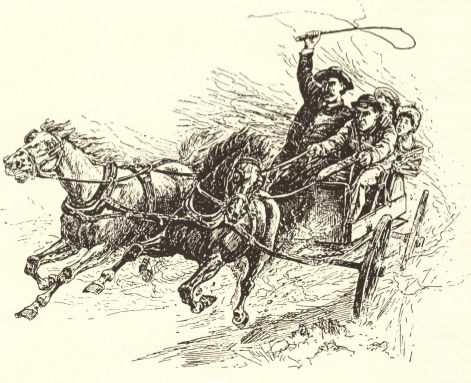
Running from a Tornado ... Perhaps?
